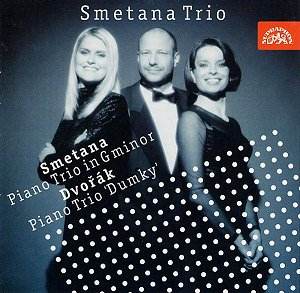|
|
Search MusicWeb Here |
|
 |
||
|
Founder:
Len Mullenger (1942-2025) Editor
in Chief:John Quinn
|
|
|
Search MusicWeb Here |
|
 |
||
|
Founder:
Len Mullenger (1942-2025) Editor
in Chief:John Quinn
|
 |
Bedrich SMETANA
(1824-1884) Piano Trio in G minor Antonin DVORAK (1841-1904) Piano Trio in E minor, Opus 90 'Dumky' Rec 6-9 January 2000, Demovina Studio, Prague |
| CD available for post-free online mail-order or you may download individual tracks. For some labels you can download the entire CD with a single click and make HUGE savings. The price you see is the price you pay! The full booklet notes are available on-line. | |
|
NOTE • Click on the button and you can buy the disc or read the booklet details • You can also access each track which you may then sample or down load. • Further Information. |
|
|
It is pleasing to find that Supraphon issues are making their way once again into the British and European markets for this company has a justifiably proud record of promoting and nurturing Czech music in particular and the wider repertoire beyond. There are high standards on display here, both in the performances and in the production, and if the recording is on the resonant side, it has abundant atmosphere and presence, and it therefore serves the music well.
And what wonderful music it is. More than Dvorak, Smetana is a composer who is too little known beyond the handful of famous pieces which keep his reputation alive on the international scene. This Trio is an excellent piece, fully worthy of his genius. The music was his creative reaction in 1855 to deep personal tragedy: the death of his three-year old daughter, Bedriske (whose younger sister, Gabriela, had died the previous year).
A descending chromatic theme is present in each movement (eg TRACK 1: 0.00), and is first heard near the beginning of the work, expressively played by the violin. Gabriela Demeterov, violinist with the Smetana Trio, characterises this theme perfectly, imbuing the music with genuine pathos. However, and somewhat unusually, all three movements adopt quick tempi, so that in order to accommodate his motto theme, Smetana added a short introduction to the finale. The second and third movements each have dance characteristics, based infectiously on the polka (TRACK 2: 1.00) and the skocna (TRACK 3: 7.50).
These individual features contribute to the special nature of Smetana's Trio, which is certainly one of the most important works of chamber music to have been composed in the mid-19th century, with its distinctively Czech personality. This performance really captures the essential features of the music.
Dvorak composed his fourth Piano Trio, His Opus 90, towards the end of 1890. By now he was a celebrated artist at the height of his powers. In his major instrumental works he tended to combine the natures of the Czech national style and the Viennese classical inheritance, the influences which were both crucial features in his artistic development. He was always willing to incorporate idiomatic dance elements into concert and chamber music; and so it was that he chose to adopt the dumka here. This dance has Ukrainian origins, and Dvorak used it widely, for example in the Slavonic Dances.
The Dumky Trio is an interesting blend of melancholy
expressiveness and joyful release. This effect is created in some measure
by having six contrasted movements, and it is to the credit of the Smetana
Trio that they achieve a true sense of unity in their performance (TRACK
1: 0.00). Moods tend to alternate to make their impression, using the
dance characteristic with the utmost imagination (TRACK 5: 6.21). Dvorak
himself chose this piece at the centre of the chamber music concerts over
which he presided immediately before leaving his homeland to go to the
United States. He would surely have approved of the eloquent performances
of the Smetana Trio.
|
| ADDITIONAL INFORMATION •
You can sample only 30 seconds (or 15% if that is longer) of a given track. Select from the View tracks list. Each sample will normally start from the beginning but you can drag the slider to any position before pressing play. • PLEASE NOTE: If you are behind a firewall and the sound is prematurely terminated you may need to register Ludwig as a trusted source with your firewall software.
•You will need Quicktime to hear sound samples. Get a free Quicktime download here • If you cannot see the "Sample All Tracks" button you need to download Flash from here.
|
|
|
Return to Index |